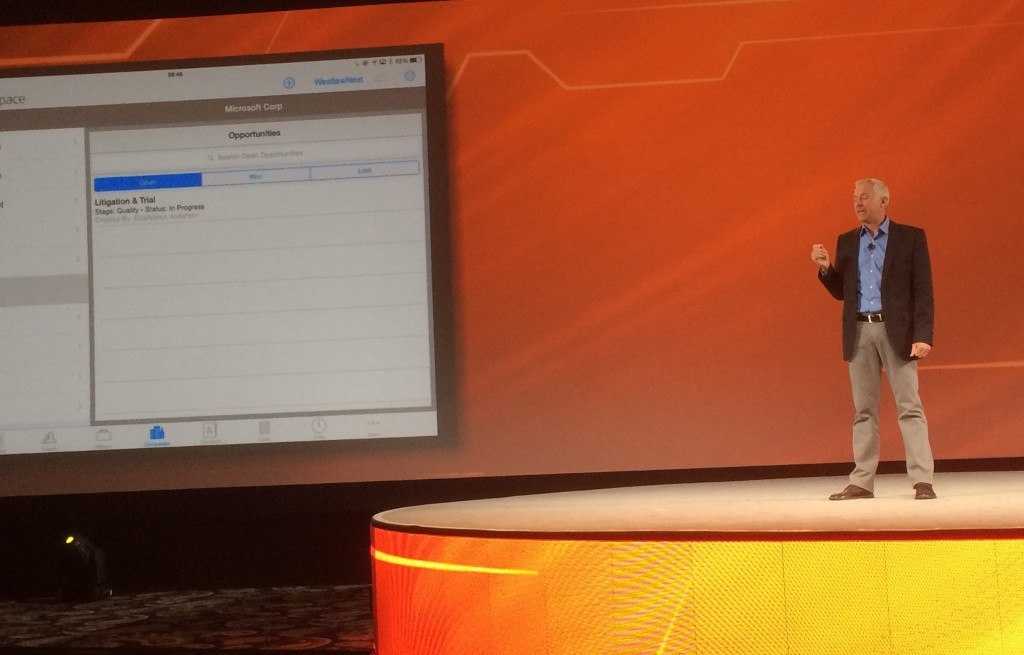At its worldwide Vantage 2015 user conference last week in Las Vegas, Thomson Reuters Elite announced an anticipated 2017 move to the cloud for its flagship product, Elite 3E, and a new emphasis on building a “customer-centric” organization.
Elite is a suite of “enterprise business management” products for law firms and other professional services firms that handle financial management, client and matter management, business development and risk management. Within the legal field, Elite’s customers are mid- to large-sized law firms and corporate legal departments.
Numbers provided by the company indicate that 4,300 firms in 42 countries use Elite products. That is an increase of 100 firms from the number given at last year’s conference. While in Las Vegas last week, Elite executives announced that they had just signed a contract with one of the largest law firms in the world, Freshfields Bruckhaus Deringer, for the Elite 3E practice management platform.
The biggest news to come out of last week’s conference was that Thomson Reuters has committed to release a cloud version of 3E sometime in 2017. The announcement was made by Eric Sugden, chief technology officer for Legal Enterprise Solutions (LES), the TR division formed last year that combined TR’s Elite and Serengeti businesses.
“We’re committed to bringing 3E to the cloud in 2017,” Sugden told a group of journalists at a media briefing on the first day of the conference. They are announcing it now, two years in advance, with the knowledge that law firms have a long planning cycle, he said.
There will be a fully hosted version and perhaps also a hybrid version bridging the cloud and an on-premises installation, Sugden said.
For law firms, advantages of the cloud version will include faster set-up and data migration and also the elasticity to handle the greater demands of month-end operations but to scale down during other periods.
Client Advocacy

Eric Ruud
Eric Ruud, who last September was named managing director of the then newly formed LES business, detailed plans to create a more “customer-centric” organization. “This doesn’t mean we haven’t been focused on customer service,” he said, “but now we will be looking at it more holistically as an advocate for the customer.”
To that end, Ruud announced the formation of a client advocacy team and the creation of a new position, vice president of customer advocacy, filled by Patrick Hurley, who was formerly vice president of global expansion at TR.
“Customer advocacy ensures there is a consistent, continuous focus on and commitment to what is best for our customer,” Hurley said at the media briefing. “Customer advocacy serves as the voice of the customer, cross-functionally, making it easier for you to do business with us.”
Relaunch of Elite Community

Elisabet Hardy
In a related announcement, Elisabet Hardy, Elite’s vice president, global product management & marketing, said that Elite is relaunching its customer community. I wrote about this two years ago when it first launched, describing it then as a social-network-like platform for customers of Elite products to connect with each other to share ideas and ask questions.
Apparently, it never gained much traction. Hardy attributed that both to customers not being ready for it and to Elite’s failure to do enough to support its success. “We can’t just build it and expect that they will come,” she said. “We have to support it.”
That is what they plan to do going forward, by devoting more resources and programming to the community and by encouraging greater participation by Elite employees. They also plan to seek greater participation by outside programmers and developers who work with Elite products.
New Capabilities for Workspace
Also at last week’s media briefing, Elite executives showed off new capabilities for Workspace, Elite’s platform for integrating disparate products. The new capabilities will be included in an update to the product due out in July.
I first wrote about Workspace in 2013, when TR announced its pending launch. I described it then as an “attempt to bring together distinct but related products within an environment where they share a common workflow and a common look and feel, across both web and mobile devices.” The formal launch came nearly a year later, initially integrating two Elite products, Elite 3E for financial management and MatterSphere, a Microsoft Office-based matter-management platform.
Now, the Workspace integration also includes Business Development Premier, a marketing and CRM platform. That means that users can now see business development information for a client alongside financial information and explore the firm’s relationships with that client.
In addition, Workspace is no longer limited to simply viewing information. Users can take actions within Workspace and have them propagate across the integrated systems. For example, if a user makes a change to a contact within Workspace, the change will flow back into 3E and be reflected there.
User Base
As of last week, Elite products were being used by 4,300 law firms in 42 countries. That included:
- 153 firms with Elite 3E.
- 270 firms with Business Development Premier.
- 211 firms with MatterSphere.
- 401 firms with eBillingHub.
- 3,161 firms with ProLaw.
Taking those products to new countries and regions will be a focus for the year to come, Eric Ruud said at the media briefing. “We will be expanding our global footprint,” he said and looking to grow in new regions, including India.
Note: Thomson Reuters paid my travel expenses to attend the conference.
 Robert Ambrogi Blog
Robert Ambrogi Blog